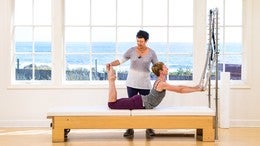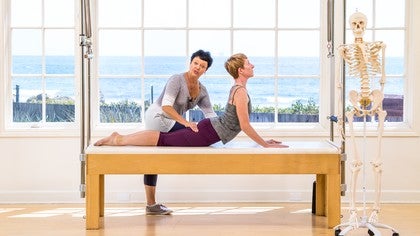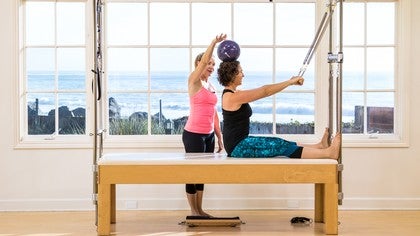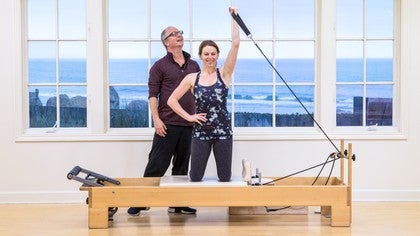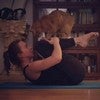Description
About This Video
Transcript
Read Full Transcript
Hi, I'm Kara Reeser and I'm here with my colleague and friend Laura Karpinski. And um, we're here to do a tutorial. And the subject of this tutorial is to look at the way the necessity of the pelvis moving on the femurs to create fluids. Final articulation. Okay. So here's how we're going to do this. So as PyLadies teachers, we're really dedicated to this idea of articulation of the spine, really fluid articulation, the spine in both flection and extension, which is what we're going to look at today. Okay?
So a lot of us use this term where we like to think of the spine moving one vertebrae at a time, which I think it's a really fine image except for if we're not including the pelvis, we're probably not going to get this full articular fluid sequential movement that we're talking about. Okay. So Laura and I are going to do some, some exercises to help demonstrate this, but I want to put a couple images in your mind first. So the first thing I want you to think about is your pelvis. Okay? And I'm going to just come around here and, um, I want you to see that your pelvic mass is one bone, right? I mean, it's two bones on either side, but when it comes to your sits bones and the top of your pelvis to the pubic bone, we're talking about one mass, right? And of course, you know this, but the pelvis is attached to the lumbar spine, but it's also attached to the hip to the Femur, which creates your hip socket. So the image that I want to bring today is that we imagine that the entire pelvic mass, right? This entire pelvic mass is your final vertebra of your, of your spine, right?
So when we're working with this idea one vertebrae at a time, I want us to be looking at the articulation between the pelvis and the Femur as our primary mover. So we sort of pull our lens back and obsess less on seeing this kind of deep, um, articulation in the lumbar spine. But we allow the pelvis to freely move and that that alone is going to create the articulation that you're desiring in the lumbar spine. Okay. So, um, the other point I wanna make is that the axis of rotation, right when you're looking at this, cause you obviously aren't going to see your client's hip socket like this cause they have all sorts of like muscles and skin and stuff on top. But what you want to be visualizing is this axis of rotation right here.
So when I'm articulating my spine or I'm looking for articulation, I'm looking at the axis of rotation right here at the hip socket and seeing that the pelvis is both spinning and gliding on those femurs. And that's gonna be really helpful I think particularly to get rid of that sort of funky spot a lot of clients have when they're trying to be successful, enroll. Um, or in rolling like a ball teaser, almost like a lot of the potties protocols. So we're going to start with Laura up here and I'm gonna have her just stand up and we're just going to look at the way this works as she's rolling down in, up from standing first. So again, here's that access of support, right? It's coming right through here. So I want to make sure she's going to start going down into flection.
And let's look at what happens here. I know you know this, but to have this in your mind is helpful that she's going to be flexing her hip as she comes down. And then as she comes up, she's going to be having to rotate her entire pelvis has to come back to that level to come through, right? So let's say Laura rolled back down for a second sweetheart, and let's see what happens if Laura doesn't complete the movement of her pelvis, right? So if she starts to move her pelvis, but she's so obsessed with flexing through her spine, what's going to happen is she's going to not really get that articulate lation at the Lumbar, uh, the level of the lumbar spine that we're looking for. So I'm thinking that if we could start thinking of this pelvic mass gone down one more time, see, watch how that pelvic mass is that one vertebrae, right? And then here comes that Vertebra, it comes up first and these guys will follow naturally. That's just the nature of the way the spine. And the pelvis work. Okay, we're going to go to the table and look at this [inaudible] I'm going to go really quickly review this, uh, the idea of the pelvic clock because I think it's really the best way to notice whether or not your pelvis is fully rotating. Again, on the femurs during spinal articulation.
So pelvic clock, Laura's lying supine and the, the her pelvis, the clock is facing the ceiling directly. So remembering that 12 o'clock is naval, six o'clock is pubic bone. Three o'clock is towards me to the left and nine o'clock is over to, uh, towards the camera towards you. So, um, now here's what I want you to do. When you're monitoring this, I want you to put your hand, one of your hands on the ass and the other hand find your client's sit bone. It's okay. You can get in there. It's all good. Find that sit bone. And then when Laura moves her pelvis to the 12 o'clock position, what I want to feel is that Asi is going down as the sit bone goes up and back down. Laura. Good again. So watch the watch the pelvis from this end, right?
Her Asi is goes down and her sit bone comes up, right? That tells me when I see that, that she's actually really spinning her pelvis on her femurs, which is going to, and she's going to do it again and I'll step back and then notice she gets this really beautiful, easy flection in that lumbar spine right now that's easy to do lying down. But coming to that position, which we'll do in a few minutes sitting up is more difficult to compute. So you want to get it in this supine position. Okay, now that's the same. Same idea where we're going to six o'clock, six o'clock. Well, let me just point out one more thing actually. Let's also notice that when Laura goes to 12 o'clock her asi has comes down, her sits bone, comes up, and her hip goes into extension, right? So to create lumbar flection, she's creating hip extension.
So that's just something else. Another way to look to see if your client or in yourself, if you're being successful now to six o'clock six o'clock it's going to take us into spinal extension and it's going to take us into hip flection. So again, I want you to see that because what's going to happen now is her ass, her sits bones are going to go down and her asi is, are going to come up into my hands, right? So and back down. So even though she might be thinking, Oh yeah, I want to articulate my spine and extension, she still has to start from the bottom, from the sitz bones, right? So the sits bones go down, increased hip flection, kind of let go there, Lord, let that go. Good. And then back down, right? So now notice again, as the sits bones go down, the Asi has comes back, she gets that comes up, she gets increased hip flection, her spine gets extended. That's the nature of it, right? So come back down. So if Laura decided to think about articulating her spine, she may do something more like pick up her spine from the middle.
Right? Which would not sequence that spine into extension in that same way. So that's why that bottom vertebra, that pelvis has a final vertebra is such an important view. All right, so let's get you sitting and look at this from a sitting perspective. Okay? Okay, so now what we're going to do, okay, we're going to use this little half roller dealio. I love these, but checking out this, this is sort of like the bottom of Laura's pelvis, right? Sitz bones, right? So that's how we move ourselves into spinal flection.
Extension is by changing where we are. I often refer to the bottom of the Pella says my rocker wrongs, right? So you could imagine if people would do that enrolling like a ball, they might be a little bit more successful. So we're going to put her on top here and just sort of give her the feeling, right? So this is the way I teach people. Spinal articulation is from the pelvis.
So the feeling here is to have Laura, again, she's going to move her, sits bones towards the back of her knee and her asi is going to come backwards, right? And that's gorgeous. And that's going to bring her into a beautiful spinal flection. And then as she comes back up, right, her pelvis is going to go in the opposite direction. She can go to six o'clock where her sits bones come back and she'll go into a little bit of extension, right? So she can start to feel that rocking. Hold your thorax back a little bit, Laura, and let this be in just your pelvis for a moments.
They can see that movement there. Yeah, exactly. And then come back up. So when you do this on your own, you want to kind of keep your thorax, your upper thorax in one position, and Gloria come on back into that 12 o'clock position, right? And then you can really see that beautiful lumbar, um, flection. And then as she comes back up, lumbar extension. Perfect. Right. Great. So let's, I'm going to pick this up. It was beautiful. And then we're just going to take sort of a one of like a Cathy grant set up backwards and we're going to look at this initiation, right?
So now Laura has felt that imaginary vertebra underneath her. And she's going to find her way down and she's very good at executing this. But again, watch, she's changing her pelvis, her hips come into extension and therefore she's laid down, right? She doesn't have to push down to look for articulation. And then as she comes up, she has to sort of think to hold her pelvis back for a few moments until her rib cages up and then she can come up to upright again. So keeping in mind, she's taking her pelvis from the vertical plane and space and she's bringing it all the way to the horizontal. Right? So if you cross sectioned her top, you are, her pelvis would go from here and it's going to fully rotate, right? Gorgeous. Now that's going to be the same straight in your legs, honey.
That's going to be the strange same change that's going to be the same in roll-up, right? So enroll up. The difference is she's going to keep her thorax, her upper thorax flexed. So as she does this, watch the pelvis, it's the same movement. Yep. She comes into hip flection as she comes forward. And then she's going to come down, right? And her pelvis again fully rotates. This is the access of support. Let's look at that one more time.
So this is what I want you to add when you're thinking about helping people with spinal articulation. Right? And perfect. Okay, good. I want to look at extension and a couple of different ways in which the pelvis has to be moving on the femurs, the hip during extension. Two two ways. We're going to look at it. So let's get you up Laura on all fours and we're going to look at that in, in a quarter pad and then we'll look at it with straight legs.
And it's a different action on the hip with the spine. So in cat, right? Again, um, Laura's going to be primarily thinking about changing her pelvis on her femurs to articulate her spine. So let's start in extension, full extension, Laura. Aha. Beautiful. And let's see this again. We'll review what happens. Inflection, right? So here's the axis of support. Again, she's gonna fully rotate sitz bones go this way. Asi Go, Asi as go up. Her spine gets flexed. Right now in the six o'clock or in the extension, the sits bones come up, the Asi is go down and her spine is extended, right? So let's look at the front of the hip as we do this. Again, during the flection moment, she's going to be extending the front of the hip.
So you wanna look right here and see hip extension, okay. In the extension moment of the spine, her hip is getting flexed, right? So instead of looking here, you could find out a lot of information. Let's go one more time, Laura, at looking at if she was successful at hip extension, she's gonna have been successful at spinal flection. So again, going into the opposite direction, she's going into, um, hip flection, right? Full hip Fletcher, my fingers there. You can see that.
Then you get that really nice fluid extension of the lumbar spine. So that's her moving through that vertebrates to the Laura, let's just have you go rolling all the way up as if you were doing cat on the push through bar. So Watch, watch what she has to execute. Just going to walk her hands back and then she's gonna roll all the way up. And again, that pelvis is what's going to have to move there to bring her all the way up. Right? So that's what we want to look for. Executing fully. Okay, beautiful.
Okay, so now let's lie you on your belly with your head facing that way I feel like swan is a place where I can get super confused. You know, now we're talking about moving into extension from the top, meaning she's initiating the spinal motion from her head. [inaudible] so she's going to extension. So there's a moment as she's going to come up into extension from the top, we're now, her pelvis is going to have to rotate 12 o'clock and she's going to need to complete hip extension, right? And enrolling back down. So here's the axis of rotation. So before you go up again, Laura, I'm just going to say this to everybody. When we were in quad or pet, the extension work brought the hips into flection, the extension of the spine, work in swan or anything with a straight leg that's in the swan family. And you know what those things are in your protocols.
The hip needs to go into extension, full extension during a extension of the spine. Okay, so let's watch that again. Here comes her head, she's going to roll up. Now she doesn't have to do it immediately, but by this point she has to be working her hip extensors to bring her up and satisfy the completion of that extension. So at the Laura didn't bring her pelvis. If she held her pelvis still and she came up, she would be limited and congested in her extension. As she lets her pelvis come through, she's able to complete that task. So again, that's your pelvis as your final vertebra.
Let's look at that one more t one more time. She's so beautiful. She's a great executer of this material. So here she comes, head first, chest comes through and here's that pelvis, rotating hip sockets, moving hip extension and back down. Good. Good job. Come on. Up to seated. And, um, so, so guys, what, what we're hoping to help you with here is, you know, as you're cuing and looking for people to have this fluid, one vertebrae at a time, spinal mobility, that it might be helpful for them to know that part of what you're asking them to do or asking yourself to do is to really, really move your pelvis. The pelvis is in, is it's really out an important moving event during spinal articulation. So, um, I'm going to take you, uh, Laura into a, a tower workout and, um, you can join along and we're going to be really using this image to, um, motivate Laura's spine in articulation during the tower class.
So thanks a lot for watching and we'll see you at the tower class.
The Teacher's Corner: Hands-On Adjustments
Comments
thank you
As the legs move away from the trunk you will have to do the action of 12:00 to avoid the pelvis being pulled to 6:00. This is the counter movement needed to manage the weight of the legs. Is that clear?
You need to be a subscriber to post a comment.
Please Log In or Create an Account to start your free trial.
